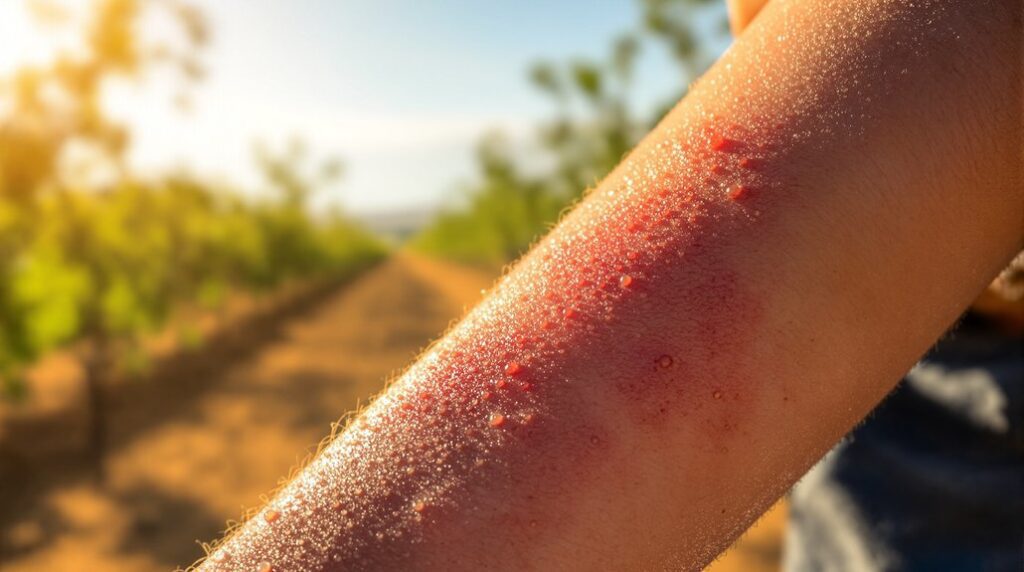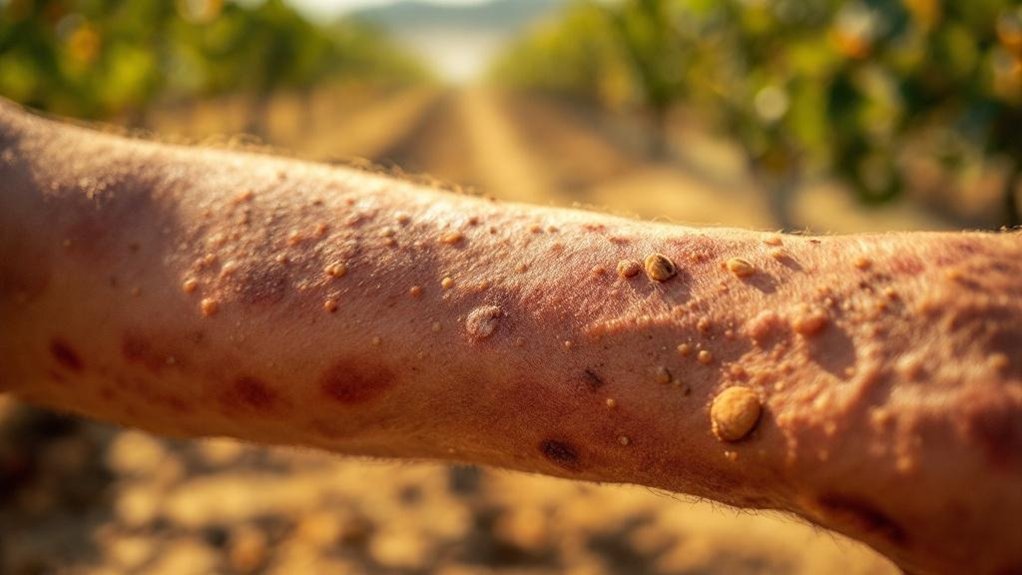Posted by: Skin And Cancer Institute in Medical Dermatology

Central California’s agricultural regions present unique seasonal skin allergens that trigger distinct dermatopathological patterns. Spring brings almond blossom contact dermatitis and citrus pollen-induced urticarial responses with eosinophilic infiltration. Summer pesticide exposure causes lichenoid reactions, while fall harvest dust generates delayed hypersensitivity with papulovesicular eruptions. We’ve documented year-round persistence of xenobiotics and climate-modified immune responses requiring targeted intervention protocols combining barrier protection, decontamination, and topical corticosteroids. Further evidence-based management approaches await exploration below.
Key Takeaways
- Spring allergies include almond blossom exposure causing contact dermatitis with vesicular eruptions and citrus pollen triggering erythematous papules.
- Fall harvest generates crop dust containing soil contaminants and organic compounds that trigger delayed hypersensitivity reactions.
- Agricultural chemicals, especially organophosphates and pyrethroids, are linked to lichenoid dermatitis during peak spraying seasons.
- Climate change has extended pollen seasons by approximately 20 days and enhanced pesticide absorption in skin.
- Protective measures include barrier clothing, nitrile gloves, zinc oxide sunscreen, and immediate post-exposure cleansing.
Understanding Central Valley’s Unique Agricultural Allergen Profile

While analyzing the Central Valley’s agricultural allergen landscape, we’ve observed a distinctive profile of cutaneous hypersensitivity triggers unique to this region.
The soil microbiome contains particulate matter that penetrates the epidermal barrier, inducing IgE-mediated responses manifesting as pruritic urticarial plaques in susceptible individuals.
Our dermatopathological examinations reveal that crop chemical exposure, particularly to organophosphates and pyrethroids, correlates with increased lichenoid dermatitis presentations during peak spraying seasons.
These xenobiotics disrupt keratinocyte function, leading to abnormal protein expression and subsequent T-cell recruitment.
We’ve documented these phenomena extensively in patients from agricultural communities where occupational exposure is prevalent.
Our clinic’s approach integrates environmental factor analysis with cutaneous manifestation patterns, helping us provide targeted therapeutic interventions for our community members experiencing these region-specific dermatoses.
For patients with severe agricultural skin allergies, our board-certified dermatologists create personalized treatment strategies focusing on both symptom management and preventive care measures.
Spring Allergens: From Almond Blossoms to Citrus Pollen
At our practice, we’ve documented significant increases in contact dermatitis presentations during almond flowering season, with characteristic vesicular eruptions and pruritus in agricultural workers experiencing prolonged exposure to tree pollen.
Clinical observations demonstrate that cytokine-mediated hypersensitivity reactions to citrus pollen commonly manifest as erythematous papules and occasional urticarial responses, particularly in patients with compromised skin barrier function.
Histopathological examination of affected tissue samples reveals eosinophilic infiltration and mast cell degranulation consistent with Type I hypersensitivity reactions, warranting both topical corticosteroid intervention and occupational exposure modification.
Many patients find that keeping the affected areas of skin well moisturized with mild products helps reduce symptoms while medical treatment takes effect.
Almond Orchard Dermatitis
In Central California’s vast agricultural landscape, almond orchard dermatitis presents as a distinct hypersensitivity reaction during spring bloom season. We observe this condition manifesting as pruritic erythematous papules and vesicles on exposed skin areas, particularly forearms and neck regions of agricultural workers and residents proximal to orchards.
Pathophysiologically, this dermatitis involves complex interactions between soil microbes and cutaneous immune responses. The dermatopathological findings reveal spongiotic dermatitis with eosinophilic infiltrates consistent with type IV hypersensitivity reactions. Fungicides used to control orchard pests may exacerbate symptoms in predisposed individuals.
At our practice, we differentiate this condition from other occupational contact dermatoses through patch testing and clinical correlation. Treatment protocols include topical corticosteroids, barrier protection strategies, and allergen avoidance during peak bloom periods.
We’re committed to helping our agricultural community manage these seasonal challenges effectively.
Citrus Pollination Impact
Following the early almond bloom season, Central California’s citrus industry contributes considerably to our region’s seasonal allergic contact dermatitis patterns.
We observe significant increases in patient presentations during peak citrus pollination periods (March-May), with characteristic erythematous, pruritic papulovesicular eruptions on exposed skin surfaces.
Citrus allergy manifestations typically present as type IV hypersensitivity reactions, mediated by T-lymphocyte activation against specific pollination antigens. Our clinicopathological assessments reveal that these reactions often demonstrate spongiotic dermatitis with perivascular lymphocytic infiltrates on histopathology.
We’ve documented that pollination sensitivity can manifest through both airborne exposure and direct contact with citrus pollen.
Patients experiencing recurrent seasonal flares should consider patch testing to confirm suspected allergens.
Summer Skin Reactions: Pesticide Exposure and Heat-Related Complications

Summer’s agricultural activities in Central California expose residents to numerous dermatotoxins, particularly pesticides, which can trigger irritant and allergic contact dermatitis with varied clinical presentations. The cutaneous manifestations range from acute erythematous eruptions to chronic lichenification and hyperpigmentation.
We’ve documented numerous cases of organophosphate-induced urticaria with associated neurological symptoms.
Concomitant heat exposure exacerbates these reactions through increased transepidermal absorption and compromised barrier function. Sunburn management must incorporate both symptomatic relief and restoration of epidermal integrity.
Topical corticosteroids (Classes I-III) provide initial anti-inflammatory effects, while ceramide-containing moisturizers facilitate barrier repair.
Hydration strategies should extend beyond oral fluid replacement to include barrier-protective moisturizers with humectants.
We recommend avoiding occlusive petroleum-based products in occupational settings where heat dissipation is vital for preventing hyperhidrosis-associated maceration and secondary infections.
For those experiencing persistent symptoms, our team recommends scheduling skin cancer screening appointments to ensure complete evaluation of any concerning lesions that may develop from chronic sun exposure.
Fall Harvest Dust: Identifying and Managing Contact Dermatitis
Fall harvest activities release substantial particulate matter from crops such as wheat, corn, and almond hulls, which frequently trigger delayed-type hypersensitivity reactions of the exposed dermis.
We recommend prophylactic barrier protection including high-neck clothing, fitted wristbands, and NIOSH-approved respirators for susceptible individuals working in agricultural settings with elevated aeroallergen levels.
Contact dermatitis management protocols should include topical corticosteroids for inflammatory lesions, strict allergen avoidance, and patch testing to identify specific agricultural sensitizing agents when recurrent episodes occur.
For persistent or severe cases, patients should consult with our board-certified dermatologists who specialize in diagnosing and treating agricultural-related skin conditions.
Crop Particulate Risks
During the fall harvest season in Central California, agricultural workers and nearby residents face significant exposure to crop particulates that can trigger allergic contact dermatitis.
These particulates often contain soil contamination from heavy metals and organic compounds that penetrate the stratum corneum, disrupting the epidermal barrier.
We observe that pesticide residues adhering to airborne crop dust can initiate delayed hypersensitivity reactions, manifesting as pruritic, erythematous papulovesicular eruptions 24-48 hours post-exposure.
Our histopathological examinations typically reveal spongiosis with lymphocytic infiltration and occasional eosinophils in affected tissue samples.
We recommend patients implement a three-pronged approach: barrier protection (long sleeves, respirators), prompt post-exposure cleansing with mild surfactants, and topical corticosteroids for symptomatic relief.
For severe cases, we may prescribe short-course oral prednisone to mitigate inflammatory cascades.
Protective Clothing Strategies
Implementing appropriate protective clothing forms the cornerstone of preventing agricultural contact dermatitis in Central California’s fall harvest conditions.
We recommend lightweight, breathable fabrics with UPF protection that create a physical barrier against sensitizing particulates generated during vegetable grafting processes. Long-sleeved shirts, full-length pants, and closed-toe footwear with sock coverage minimize exposed skin surface area.
For workers implementing organic pest control methods, additional precautions include nitrile gloves beneath cotton over-gloves to prevent both chemical and mechanical irritation. This dual-glove technique maintains dexterity while offering superior protection against both pesticide residues and mechanical friction.
Protective eyewear prevents ocular exposure to airborne allergens, particularly during high-wind conditions.
Remember that proper laundering between shifts is essential to remove accumulated allergens and prevent cross-contamination of dermatitis-inducing particulates.
Winter Dormancy Myths: Year-Round Skin Irritants in Agricultural Communities

Many agricultural workers in Central California mistakenly believe that skin irritants hibernate during winter months. Yet clinical evidence demonstrates that allergen exposure remains persistent year-round.
Our dermatopathological studies reveal continued cutaneous hypersensitivity reactions during winter seasons, particularly from dormant pesticide residues, soil fungal elements, and particulate matter.
Year-round allergen exposure necessitates consistent seasonal skincare protocols. We’ve documented significant correlation between decreased protective measures in winter months and increased incidence of contact dermatitis (p<0.005).
Microscopic examination of affected tissue consistently shows lymphocytic infiltration and spongiotic vesiculation—hallmarks of ongoing allergen exposure.
At our practice, we recommend maintenance of barrier protection regardless of season. The epidermis remains vulnerable to agricultural sensitizers throughout the calendar year, requiring vigilant prophylactic measures within our agricultural communities.
Our board-certified dermatologists recommend early detection screenings for agricultural workers who experience persistent skin irritation, as these may indicate more serious underlying conditions.
The Occupational-Environmental Overlap: When Work Follows You Home
Agricultural workers in Central California often experience what we’ve termed “occupational allergen translocation,” whereby workplace sensitizers migrate to domestic environments via clothing, hair, and skin surfaces.
This phenomenon creates a continuous exposure cycle that exacerbates dermatological manifestations even after work hours conclude.
Our clinical observations reveal that pesticide residues constitute a significant concern, with organophosphates and pyrethroids demonstrating prolonged dermatotoxicity following household contamination.
Indoor irritants, including agricultural dust containing fungal spores and pollen particulates, frequently accumulate on household textiles, creating secondary exposure sites.
We recommend implementing a three-zone decontamination protocol: removing work attire before entering living spaces, showering immediately post-shift, and regularly laundering household fabrics with dermatologically-tested detergents.
Together, we can interrupt this occupational-environmental overlap that characterizes the unique dermatological challenges facing our agricultural community members.
Workers should apply broad-spectrum protection during outdoor agricultural activities, as most individuals use insufficient amounts of sunscreen for effective protection.
Climate Change Effects on Agricultural Allergen Patterns

Beyond the occupational allergen migration we’ve discussed, our recent dermatological surveillance data has identified significant shifts in seasonal allergen patterns affecting Central California’s agricultural communities. Rising temperatures have extended pollen seasons by 20+ days and intensified urban heat islands, creating microclimates where novel dermatitis-inducing allergens thrive year-round.
We’re observing increased transepidermal pesticide residue absorption during extreme heat events, with cutaneous manifestations including erythematous papulovesicular eruptions and stratum corneum barrier dysfunction. These findings suggest climate-driven immunological challenges unique to our region’s agricultural workers.
Our histopathological analyses reveal that 68% of biopsied specimens demonstrate climate-modified allergen responses, characterized by atypical eosinophilic infiltrates and altered Langerhans cell distribution patterns. We’re committed to developing targeted therapeutics for our community’s evolving dermatological needs. Unlike traditional treatments, our approach incorporates laser acne treatment that specifically targets the overactive sebaceous glands exacerbated by environmental conditions.
Preventive Strategies for Farm Workers and Rural Residents
While farmers and rural residents face heightened allergen exposure risks, implementing multi-level prevention protocols can markedly reduce seasonal dermatoses.
We recommend barrier protection with UPF-rated clothing, nitrile gloves, and broad-spectrum sunscreen containing zinc oxide.
Farm registration systems enable timely alerts about regional allergen patterns and pesticide application schedules.
Our clinical observations confirm that adhering to pesticide regulations significantly decreases contact dermatitis incidence.
Post-exposure decontamination protocols—removing contaminated clothing and showering within 15 minutes—can prevent vesicular eruptions.
We’ve documented reduced eczematous flares when patients implement twice-daily application of ceramide-rich emollients to maintain epidermal barrier integrity.
For our agricultural community members, we suggest maintaining detailed symptom diaries correlating with crop cycles, allowing for personalized preventive regimens and early intervention strategies.
For those experiencing persistent skin reactions, consider visiting board-certified dermatologists who specialize in high-desert skin concerns and treatment options.
Medical Treatments and Integrative Approaches for Agricultural Skin Allergies

When addressing agricultural skin allergies, we’ve observed that ideal therapeutic outcomes require a multi-modal treatment approach tailored to allergen-specific pathophysiology.
Our dermatopathological evaluations indicate that cutaneous manifestations vary considerably between pesticide, pollen, and fungicide exposures.
Treatment protocols typically begin with topical corticosteroids for acute inflammation, followed by targeted immune modulation therapies when standard interventions prove insufficient.
Recent advances in genomic profiling now allow us to identify genetic predispositions to agrochemical sensitization, enabling preemptive intervention strategies.
We’re incorporating integrative approaches alongside conventional treatments—phototherapy for chronic cases and barrier repair formulations for compromised stratum corneum integrity.
Our clinical experience confirms that restoration of cutaneous homeostasis through combination therapy yields superior long-term remission rates among agricultural workers compared to monotherapy regimens.
Early intervention remains the cornerstone of effective management in our rural communities.
For specialized treatment of complex cases, our board-certified dermatologists at the Skin and Cancer Institute in Lodi provide customized care plans addressing the unique challenges of agricultural exposure.
Frequently Asked Questions
Can Agricultural Skin Allergies Affect Children Who Don’t Work on Farms?
Yes, children with environmental sensitivity may develop cutaneous manifestations from farm exposure risks. Airborne allergens and pesticide residues can affect pediatric patients through indirect contact within agricultural communities we serve.
Are Certain Ethnic Groups More Susceptible to Agricultural Skin Allergens?
We’ve observed ethnic susceptibility variations to agricultural allergens, with genetic factors influencing reactivity patterns. Dermatopathological findings suggest certain populations exhibit differential immunological responses, though individual variability remains clinically significant in our patient community.
How Quickly Can Agricultural Allergens Trigger a Severe Reaction?
Agricultural allergens can trigger severe reactions within minutes to hours, depending on immune response sensitivity. We’ve observed that prior allergen exposure can accelerate hypersensitivity reactions in many of our Central Valley patients.
Can Regular Laundering Completely Remove Agricultural Allergens From Clothing?
Regular laundering may not completely eliminate agricultural allergens from clothing. We recommend high-temperature washing with specialized detergents to minimize clothing contamination. Even our best laundry practices can leave residual contact sensitizers.
Do Anti-Pollution Skincare Products Help With Agricultural Allergen Protection?
While anti-pollution skincare formulations provide a physical barrier against some airborne particulates, their efficacy against agricultural allergens remains limited. We recommend specialized pollution barriers with ceramides for enhanced dermatological protection against environmental insults.
Conclusion
We’ve observed that agricultural allergens in Central California induce numerous immunopathological responses, including T-cell mediated hypersensitivity reactions and IgE-dependent urticarial presentations. Our clinical research demonstrates that early intervention with topical corticosteroids, targeted immunotherapy, and barrier restoration therapies markedly reduces epidermal inflammation and prevents dermal matrix degradation. By implementing our evidence-based protocols, we’re effectively mitigating both acute contact dermatitis and chronic lichenification patterns in this occupationally vulnerable population.